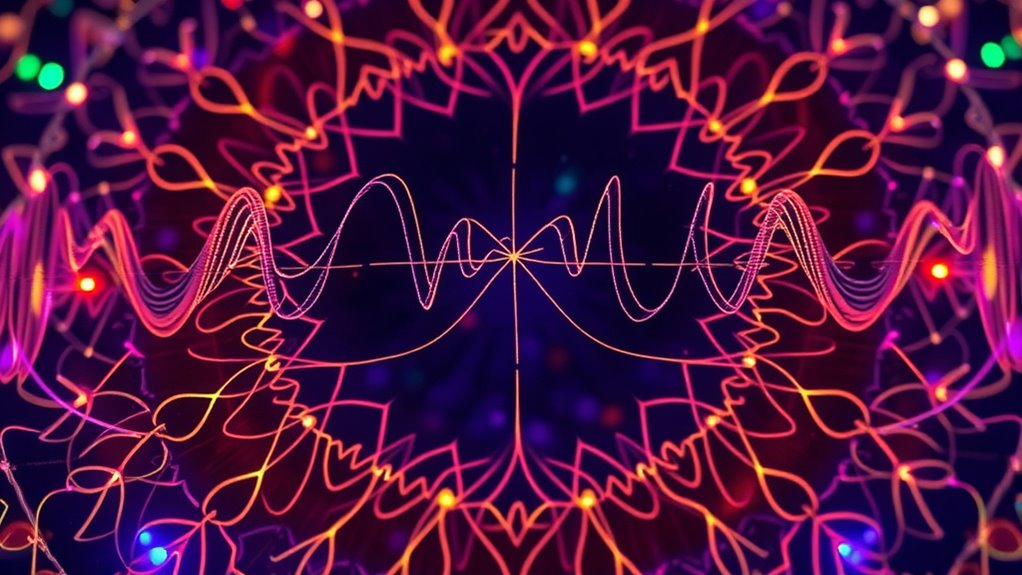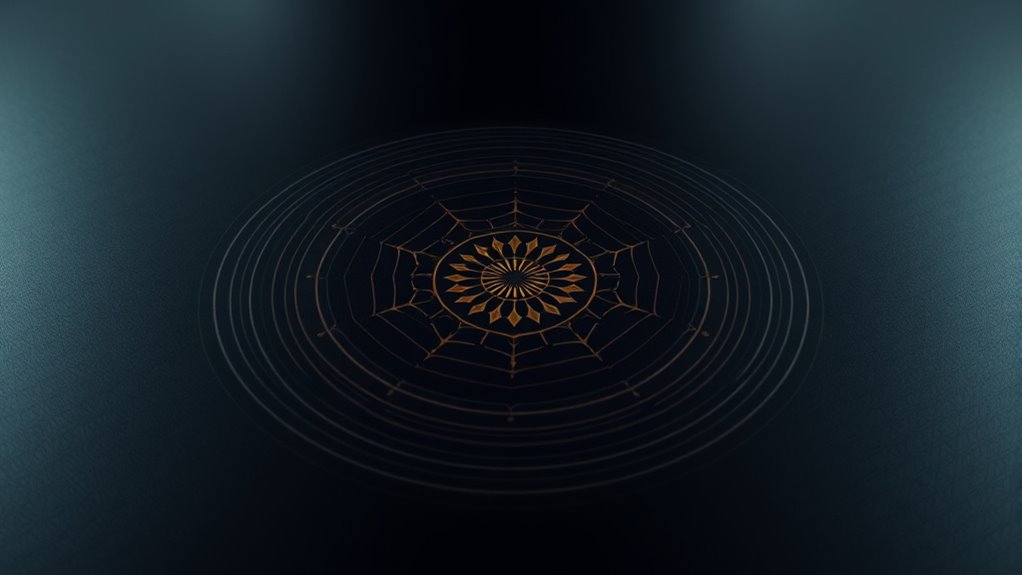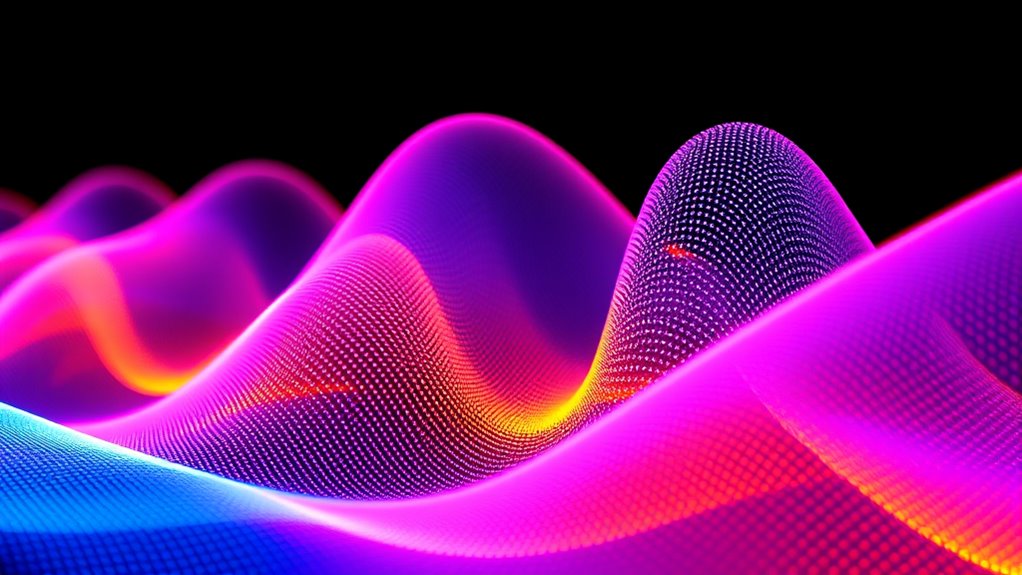Discover how the hidden geometry behind music and sound waves shapes your auditory experience. Mathematical patterns, symmetry, and fractals form the foundation of sound visualization, from wave shapes to complex acoustic structures. Understanding these geometric principles reveals how harmonics, tuning systems, and natural patterns influence sound perception. By exploring these concepts, you unseal the beauty and science behind sound design and acoustics—if you continue exploring, you’ll uncover even deeper insights into this fascinating world.
Key Takeaways
- Sound waves exhibit geometric patterns like sine, square, and fractal shapes that influence their propagation and perception.
- Musical harmonics and overtones are structured through geometric relationships, shaping timbre and tonal harmony.
- Symmetry and fractal tessellations in sound design create natural, immersive acoustic environments and complex textures.
- Visualization of sound waves as geometric forms reveals hidden patterns related to frequency, phase, and amplitude.
- Understanding the geometry of scales and tuning systems uncovers the mathematical foundation behind musical harmony.
The Mathematics Behind Sound Waves

Understanding the mathematics behind sound waves is essential to grasp how music and sound work. Sound wave symmetry plays a key role in shaping how waves behave, influencing their form and interaction. Symmetrical sound waves, such as sine waves, are simple and smooth, making them easier to analyze mathematically. Acoustic topology refers to the geometric arrangement of these waves in space, affecting how they propagate and interact within different environments. By studying these mathematical principles, you gain insight into how sound behaves, from the vibrations of a guitar string to complex audio signals. Recognizing the relationship between sound wave symmetry and acoustic topology helps you understand why certain sounds resonate and how sound waves can be manipulated for better acoustics or musical effects. Additionally, understanding sound wave behavior can lead to innovations in audio engineering and sound design.
Visualizing Sound: From Waves to Geometry

Building on the math behind sound waves, visualizing these waves can reveal patterns and structures that are not immediately obvious through numbers alone. Sound visualization transforms wave data into geometric shapes, highlighting wave geometries that reflect frequency, amplitude, and phase. By plotting sound waves, you can observe how complex patterns emerge from simple oscillations, making it easier to analyze musical tones or acoustic properties. The table below illustrates common wave geometries and their characteristics:
| Wave Geometry | Description | Sound Type |
|---|---|---|
| Sine wave | Smooth, periodic oscillation | Pure tone |
| Square wave | Sharp transitions, harmonics | Electronic sound |
| Triangle wave | Linear rise and fall | Musical tone |
| Sawtooth wave | Asymmetrical, rich in harmonics | Synthesized sound |
| Complex wave | Multiple overlapping waves | Real-world sounds |
Understanding these wave geometries is fundamental in sound synthesis and designing unique audio textures.
Harmonics and the Structure of Musical Notes

When you listen closely to a musical note, you’ll notice it’s made up of multiple overtones that shape its unique tone. These harmonics follow specific patterns known as the harmonic series, which influence the instrument’s timbre. Understanding these structures reveals the hidden geometry behind the sounds you hear. Affiliate relationships in music production and sound engineering demonstrate how knowledge of harmonic structures can be applied practically.
Overtones and Timbre
Overtones, also known as harmonics, are the additional sound waves that vibrate at multiples of a fundamental frequency, shaping the unique quality of each musical note. These overtones influence your perception of timbre, giving instruments their distinct character. Vibrational resonance occurs when certain overtones amplify through the instrument’s structure, enhancing specific overtones that define its sound. This resonance helps your brain distinguish between different musical sources, aiding sound localization. When overtones align precisely, they create a rich, full tone that feels alive and vibrant. Your ear picks up these subtle variations, allowing you to identify the instrument or voice producing the sound. Understanding overtones reveals how complex wave interactions craft the rich tapestry of sounds you experience in music every day. Additionally, sound waves can influence brainwave patterns and emotional states, contributing to the therapeutic effects of music and sound healing.
Harmonic Series Patterns
The harmonic series reveals the organized pattern of overtones that form the foundation of musical notes. These overtones, or harmonics, follow specific frequency ratios, creating a natural structure that our ears interpret as pitch. When you explore these patterns, you notice how acoustic resonance amplifies certain overtones, shaping the character of a sound. Frequency modulation, often used in synthesizers, exploits these harmonic relationships to produce rich, complex tones. As sound waves vibrate within an instrument or space, they reinforce specific harmonics, highlighting the harmonic series’ pattern. Recognizing these patterns helps you understand why different notes have unique timbres and how composers and sound designers manipulate resonance and modulation to craft specific auditory effects. The harmonic series is truly the blueprint behind musical sound. Additionally, understanding the Golden Retriever breed’s friendly temperament can inspire composers to create warm, inviting soundscapes that evoke feelings of loyalty and companionship.
The Role of Symmetry in Acoustic Design

Symmetry plays a essential role in acoustic design because it influences how sound waves interact within a space. When structures are symmetrical, sound reflects evenly, creating balanced acoustics that enhance clarity and richness. Fractal tessellations utilize repeating symmetrical patterns, helping architects design surfaces that distribute sound evenly. However, deliberate symmetry breaking can also be beneficial; it prevents sound from becoming too uniform or echoing excessively. By introducing subtle asymmetries, you can control reverberation and improve sound diffusion. Symmetry guides the placement of panels, walls, and surfaces to optimize acoustic performance. Understanding how symmetry affects wave behavior allows you to craft spaces that sound natural, immersive, and free of unwanted echoes. Ultimately, mastering symmetry’s role enables precise control over acoustic environments.
Fractals and Complexity in Sound Patterns

You can find fractal structures in many natural sound patterns, creating intricate and self-similar textures. These complex patterns often occur in music, as well as in everyday noise, revealing hidden layers of organization. Exploring these fractals helps you understand how complexity shapes the sounds we perceive. Recognizing the relationship between personality traits and communication can also deepen our appreciation of how sound patterns influence emotional and social interactions.
Fractal Structures in Sound
Fractal structures reveal themselves in sound patterns when you analyze complex waveforms that repeat at different scales, creating intricate textures within music and noise. These fractal structures form through sound tessellations, where similar motifs or patterns recur across varying frequencies and amplitudes. You might notice these patterns in nature-inspired sounds or experimental compositions, where self-similarity appears at multiple levels. By examining the waveforms, you can see how smaller segments mirror larger sections, generating a sense of depth and complexity. This self-similar behavior contributes to the richness of sound textures, making them feel layered and organic. Recognizing fractal structures in sound allows you to appreciate the underlying geometry shaping our auditory experiences, revealing a hidden order amid apparent chaos. Additionally, understanding sound tessellations enhances our perception of how natural and man-made sounds share similar fractal patterns.
Complexity in Audio Waves
Complexity in audio waves emerges from the intricate interplay of multiple frequencies and patterns that combine to create rich, dynamic sounds. This complexity often results in sound wave distortion, adding layers of texture and depth. During audio signal processing, subtle variations can produce unpredictable yet fascinating patterns, illustrating the fractal-like nature of sound. Imagine:
- A shimmering ripple spreading across a pond’s surface
- Twisting, branching lightning in a storm
- An intricate web of vines intertwining
These visuals mirror how complex sound waves evolve, revealing hidden geometries. Such patterns are not only aesthetically enthralling but also essential for understanding how sounds are constructed and perceived. Studying these patterns and their fractals and complexity can deepen our comprehension of sound architecture and its natural occurrences, providing insights into both musical and environmental acoustics.
The Geometry of Musical Scales and Tuning Systems

The geometry of musical scales and tuning systems reveals how the arrangement of pitches creates harmonious sound patterns. Scale intervals define the distances between notes, shaping the overall structure of a scale. Different tuning systems, like equal temperament or just intonation, influence how these intervals are spaced, affecting the harmony and feel of music. In equal temperament, the octave is divided into 12 equal parts, making key changes seamless but slightly altering pure intervals. Other tuning systems prioritize pure consonances, emphasizing the mathematical relationships between notes. By understanding this geometric organization, you can see how scales are constructed and how tuning influences musical perception. Additionally, the prevalence of certain names in different cultures reflects underlying cultural values and aesthetic preferences that can influence musical styles. This geometric perspective uncovers the hidden patterns that underpin musical harmony, revealing a precise mathematical framework behind the sounds you hear.
Sound Waves in Nature: Patterns and Predictions

Just as the geometry of musical scales reveals hidden patterns in sound, similar principles govern sound waves in nature. You can observe these patterns in phenomena like bird songs, ocean waves, and thunder. These natural sound waves result from complex interactions of sound energy and wave interference, creating predictable and mesmerizing patterns. When waves overlap, they can amplify or cancel each other out, shaping sounds you hear in the environment. Acoustic patterns emerge naturally through these interactions, highlighting the interconnectedness of sound and geometry in nature.
- Ocean waves crashing onto the shore, forming rhythmic patterns
- Wind passing through trees, producing fluctuating sound energy
- Echoes bouncing off mountains, revealing wave interference effects
Artistic Representations of Sound’s Hidden Structures

Artists and musicians have long harnessed the hidden structures of sound to create visually compelling and meaningful works. Through visual art, they translate complex sound wave patterns into striking images, revealing the geometry behind music’s vibrations. These representations help audiences see sound’s intricate harmony and structure, bridging auditory and visual experiences. In sound therapy, such artistic visuals serve as tools for relaxation and healing, emphasizing the connection between sound’s hidden geometries and well-being. By incorporating geometric patterns and waveforms into visual art, creators emphasize the universal language of sound, making abstract concepts tangible. This fusion of art and science deepens your understanding of sound’s underlying order, inspiring both aesthetic appreciation and therapeutic benefits. Understanding the visual representation of sound can also deepen your appreciation for the interconnectedness of sound and spiritual well-being. Ultimately, these artistic forms make the unseen structures of sound accessible and impactful.
Future Directions: Exploring Sound Through Geometric Lenses

As technology advances, exploring sound through geometric lenses opens new frontiers for understanding and innovation. By examining acoustic topology, you can visualize sound waves as complex, interconnected structures that reveal hidden patterns. This approach enhances sound symbolism, linking physical forms to perceptual meaning. Future research might involve mapping sound frequencies onto multidimensional geometric spaces, revealing relationships previously unseen. Imagine:
Exploring acoustic topology reveals hidden sound patterns through complex geometric structures and multidimensional mapping.
- Visualizing harmonic structures as intricate geometric shapes
- Using 3D models to explore sound wave interactions
- Developing algorithms that interpret sound through geometric patterns
- Leveraging Kia Tuning techniques to manipulate sound characteristics and explore their geometric relationships
These methods will deepen your grasp of how sound’s hidden geometry influences perception and creation. As you explore these geometric lenses, you’ll decipher new ways to analyze, compose, and innovate within the sonic landscape.
Frequently Asked Questions
How Does the Human Brain Perceive Geometric Patterns in Sound?
You perceive geometric patterns in sound through neural synchronization, where your brain’s neurons align to the rhythmic structures. This process helps you recognize patterns and anticipate sounds. Auditory illusions trick your brain into perceiving shapes and patterns that aren’t physically present, amplifying this perception. Your brain actively interprets these patterns, creating a sense of order and meaning, making sound not just auditory but visually engaging through hidden geometries.
Can Geometric Analysis Predict Emotional Responses to Music?
You might wonder if geometric analysis can predict emotional responses to music. While auditory illusions reveal how our brains interpret complex patterns, geometric harmony offers insights into the structure behind these patterns. When you analyze these geometries, you can anticipate how certain sounds evoke emotions, as harmonious shapes often align with positive feelings. So, yes, understanding these geometric principles helps forecast emotional reactions to music, making your listening experience more meaningful.
Are There Specific Geometric Shapes Associated With Different Genres?
Imagine recognizing a swirling spiral in jazz or sharp, jagged lines in rock through visual pattern recognition. While specific geometric shapes like circles or triangles sometimes symbolize genres, it’s more about the overall geometric pattern symbolism. Different genres evoke unique visual patterns, but these shapes aren’t fixed. Your mind connects these patterns to emotional and stylistic cues, making genre identification a fascinating dance of geometry and perception.
How Do Cultural Differences Influence the Perception of Sound Geometries?
You might notice that cultural interpretation greatly influences how you perceive sound geometries. Perceptual variation occurs because different cultures associate distinct shapes and patterns with sounds, shaping your emotional response and understanding. For example, some cultures may see certain sound waves as harmonious, while others interpret them as chaotic. Your cultural background therefore molds your perception, leading to diverse experiences of sound geometries across societies.
Can Sound Wave Geometries Be Used to Improve Acoustic Engineering?
Imagine harnessing the universe’s most intricate patterns—sound wave fractals and acoustic symmetry—to revolutionize spaces. You can use these geometries to create perfect soundscapes, eliminate echoes, and enhance clarity like never before. By understanding and applying the hidden structures of sound waves, you’ll design acoustics that resonate with natural harmony. This approach transforms ordinary spaces into extraordinary auditory environments, pushing the boundaries of acoustic engineering to new, breathtaking levels.
Conclusion
Now that you’ve seen how geometry reveals the hidden patterns in sound, you might wonder what new melodies or insights await discovery. By exploring these mathematical and geometric structures, you can deepen your understanding of music’s complexity and beauty. Isn’t it fascinating how sound and mathematics intertwine, shaping the music we love? Keep exploring, and you might just uncover the next great harmony hidden within the waves.









